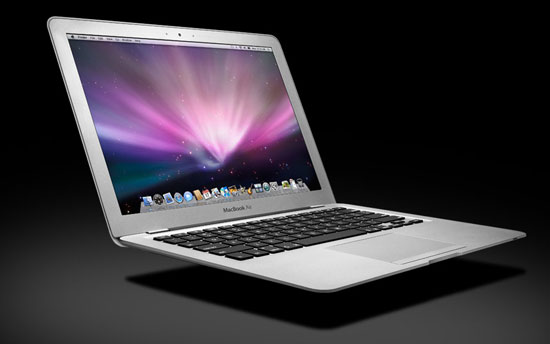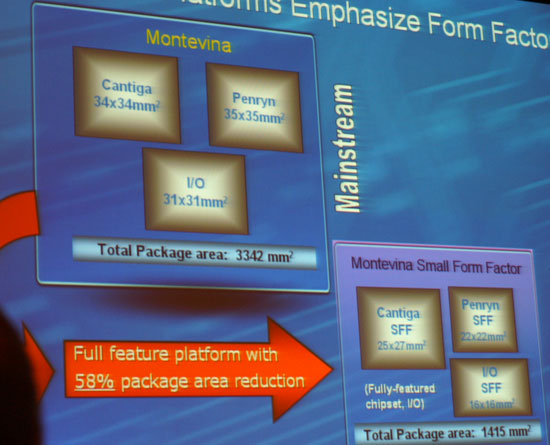
Original Link: https://www.anandtech.com/show/2420
Apple's MacBook Air: Uncovering Intel's Custom CPU for Apple
by Anand Lal Shimpi on January 15, 2008 12:00 AM EST- Posted in
- Mac
Apple just announced its MacBook Air and the thing looks stunning. If you haven’t already seen the specs, here’s what we’re looking at:
3 lbs
0.16” - 0.76” x 12.8” x 8.94” (H x W x D)
Full Size keyboard from the MacBook
13.3” 1280 x 800 LED backlit screen
2GB DDR2-667
Intel Core 2 Duo 1.6GHz or 1.8GHz, 800MHz FSB, 4MB shared L2
80GB 1.8” 4200RPM HDD or optional 64GB SSD
802.11n/Bluetooth 2.1+EDR
Starting at $1799
The MacBook Air looks to be a very well designed ultra portable, making very few compromises (no optical drive, but you get a full sized keyboard) while keeping the size down.

One feature that stood out from Steve’s announcement of the Air was that it appears to use a low-voltage Merom based Core 2 Duo instead of an Ultra Low Voltage Merom like most of its competitors.
Standard Merom (65nm) based Core 2 Duo processors run off of a 1.0375 - 1.3000V core voltage under normal operating conditions (full clock frequency). These chips range from 1.8GHz all the way up to 2.6GHz (not including Extreme Edition parts).
Low Voltage Core 2 Duo processors are lower yielding parts that can work at lower voltages, and thus Intel charges a small premium for these chips since they aren’t as common. These LV Core 2 Duos run at 0.9V - 1.2000V under normal operating conditions, and they are available in 1.4GHz, 1.6GHz and 1.8GHz speeds. We believe that these are the cores Apple is using in the MacBook Air.
Ultra Low Voltage Core 2 Duos drop operating voltage even lower, down to 0.8V - 0.975V, but clock speeds are limited to 1.06 - 1.33GHz. Mobile Penryn will eventually be offered in a ULV version, at which point we expect clock speeds to jump a bit but not enough for Apple’s needs.
Apple wanted the MacBook Air to be no-compromises, and thus the LV Core 2 Duo made the most sense. Mobile Penryn would’ve actually made even more sense, since the move to 45nm not only increases battery life but reduces thermal output; unfortunately there are no Low Voltage versions of the new core, not to mention that availability is extremely limited.
So with relative certainty we know what CPU core Apple is using in the MacBook Pro (there is no 4MB L2 Penryn and Intel wouldn’t spin a new version of a CPU just for Apple so we’re dealing with a 65nm Merom), but the bigger question is one of packaging size.
Intel’s SFF Merom: Just for Apple
During Jobs’ keynote, Apple mentioned that the Core 2 Duo in the MacBook Air was 60% smaller than standard Core 2 Duo processors. A quick look at Intel’s mobile Core 2 Duo datasheets reveals that indeed both the micro-FCPGA and micro-FCBGA packaged Meroms measure 35mm x 35mm. Is it possible that Intel designed a completely new package just for Apple?

It turns out that the answer is a surprising: sort-of. At last year’s Fall IDF Intel talked about Montevina, the successor to Santa Rosa due out in the second half of 2008. Montevina would combine a new chipset (Cantiga) with mobile Penryn. In addition to Montevina Intel will also release Montevina SFF, a smaller package version of the platform that reduces overall chip footprint by around 60%.

Pay attention to the size of the CPU, it drops from 35mm x 35mm down to 22mm x 22mm - Penryn SFF is around 40% of the size of regular mobile Penryn, which happens to be the same size as Merom.
It looks like Intel created Merom SFF specifically for the MacBook Air, a product that wasn’t in Intel’s lineup or roadmap but one that Apple needed. Remember that the first chip that will look like this wasn’t scheduled to be out for another six months with Montevina SFF.
It’s not clear whether Intel will make this custom Merom available to other OEMs (we’d suspect they would if there was enough demand), but it’s a tremendous feat on Apple’s part. This isn’t the first time Intel has put together a one-off chip for Apple; if you’ll remember, the CPU in the Apple TV was a special Dothan that wasn’t a part of Intel’s standard lineup.
We’ll have a look at the MacBook Air as soon as they start shipping, if you’re ordering one now we’d recommend taking the SSD option if you can afford it. At $999 it’s pricey, but it should help keep heat down in the chassis and performance should be better than the pitiful 1.8” HDD in the system, which we suspect will end up being its weak point.
We also can’t help but think that a Penryn based MacBook Air would be far more desirable thanks to lower thermal output of Intel’s 45nm chips. If you are fine waiting, a MacBook Air in the second half of 2008 will give you slightly better performance, better battery life and should keep your lap a lot cooler.







